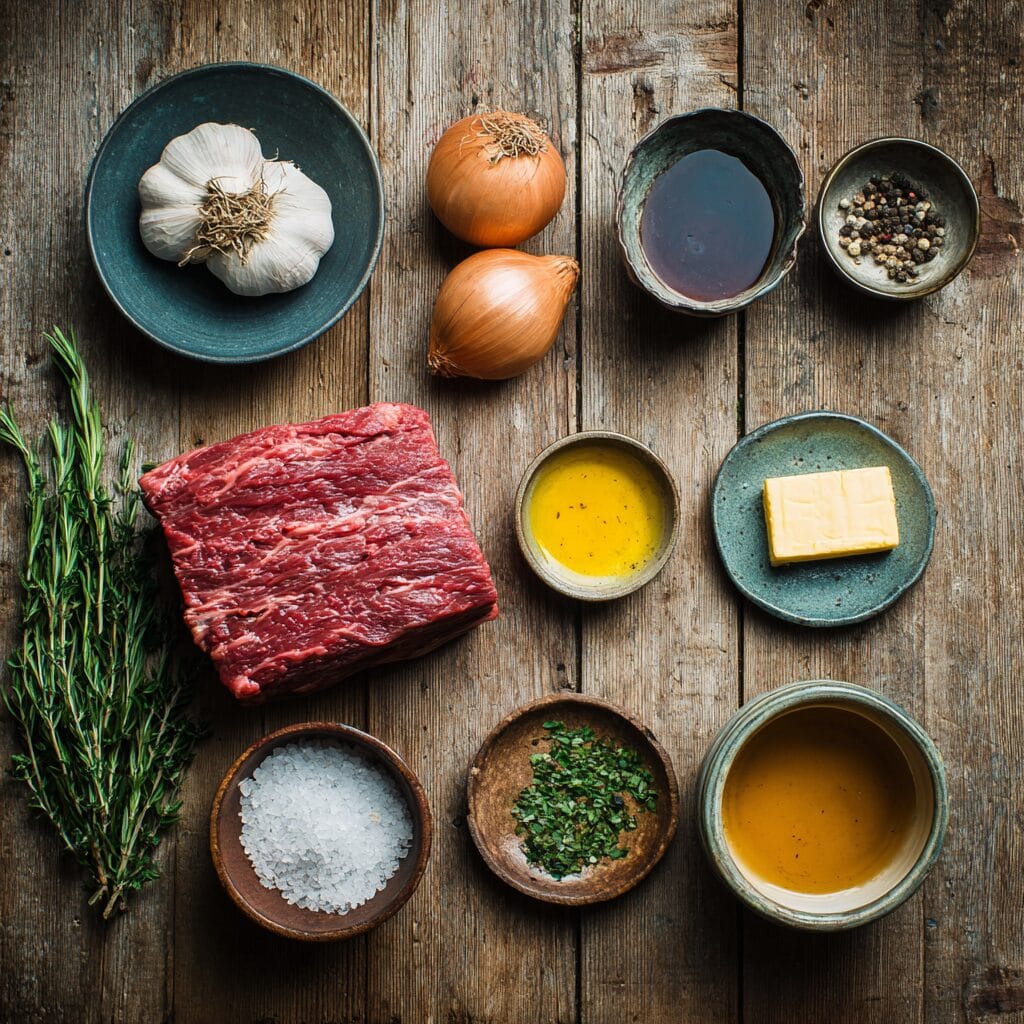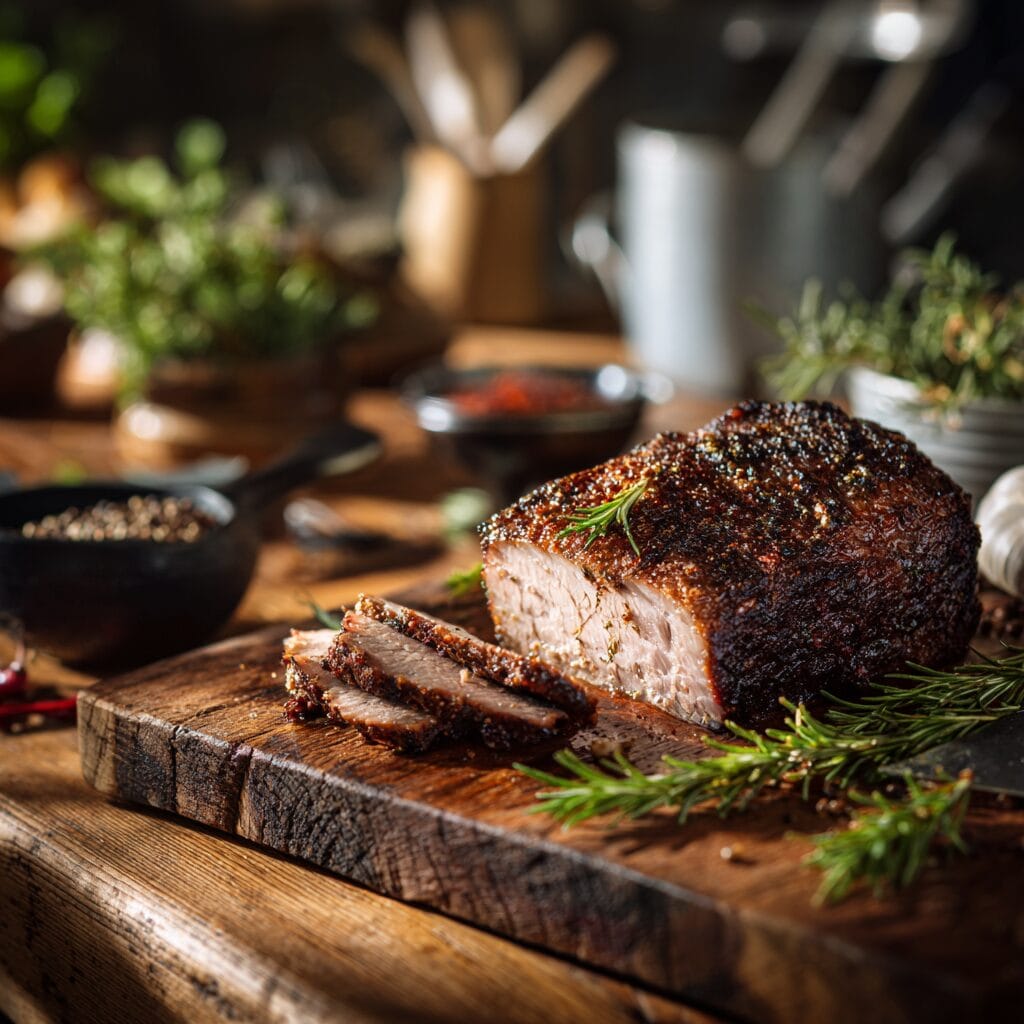Table of Contents
Gordon Ramsay Beef Brisket transforms this notoriously tough cut into melt-in-your-mouth perfection, but I learned the hard way that one wrong move can turn twelve hours of cooking into leather. During my firefighting days, our station house brisket attempts were legendary disasters until I discovered the principles that separate amateur efforts from professional results. This comprehensive guide will walk you through Gordon’s time-tested approach, combining USDA-recommended safety practices with restaurant techniques that deliver consistently exceptional results. Whether you’re feeding a crowd or mastering this challenging cut for the first time, this method removes the guesswork from one of barbecue’s most intimidating dishes, much like our barbecue steak techniques that build confidence in outdoor cooking.
Why This Gordon Ramsay Beef Brisket Recipe Works (And Where Most Go Wrong)
The Gordon Ramsay Beef Brisket method succeeds because it addresses the three critical factors that make or break this cut: time, temperature, and moisture management. Most home cooks fail because they rush the process, cook at temperatures that are too high, or don’t understand the science of collagen breakdown that transforms tough connective tissue into gelatin.
Low and Slow Temperature Control
Gordon’s approach maintains a consistent 225°F throughout the entire cooking process. This temperature is crucial because collagen begins breaking down at around 160°F but needs extended time at stable temperatures to fully convert. Higher temperatures might seem faster, but they cause the outer layers to dry out before the interior becomes tender. Food science research confirms that maintaining steady low heat produces superior moisture retention and tenderness.
Strategic Fat Management
Unlike other cuts where you might trim excess fat, Gordon Ramsay Beef Brisket requires careful fat preservation. The fat cap acts as a natural basting system, slowly rendering and keeping the meat moist during the long cooking process. The mistake most people make is either removing too much fat or placing the brisket fat-side down, which prevents this natural moisture protection.
The Stall Understanding
Around 150-160°F internal temperature, your brisket will hit “the stall” where temperature stops rising for hours. Novice cooks panic and raise the heat, but this is actually when collagen breakdown accelerates. Gordon’s method embraces this phase, using it as the transformation period that creates the signature texture.
Ingredients That Actually Matter for Gordon Ramsay Beef Brisket

Success with Gordon Ramsay Beef Brisket starts at the butcher shop, not in your kitchen. The quality and preparation of your ingredients directly impact the final result, and understanding what to look for can mean the difference between triumph and disappointment.
Your brisket should weigh between 10-15 pounds for optimal results, with a thick flat muscle and well-marbled point. Look for USDA Prime or Choice grade with a fat cap of roughly ¼ inch thickness. Avoid briskets that feel spongy or have an excessive amount of hard fat, as these indicate poor quality or improper aging. The meat should have a deep red color without any gray patches or strong odors.
For the rub, Gordon emphasizes coarse kosher salt and freshly ground black pepper as the foundation, typically in a 1:1 ratio. The coarse texture is crucial because fine salt can over-penetrate and create a cured texture rather than seasoned meat. Add garlic powder, onion powder, and a touch of brown sugar for complexity, but avoid pre-mixed seasonings that often contain anti-caking agents that can create a bitter taste during long cooking.
Wood selection matters significantly for flavor development. Oak provides a steady, mild smoke that won’t overpower the beef, while cherry adds subtle sweetness and beautiful color. Avoid strong woods like mesquite for such a long cook, as they can create an acrid taste. If you’re working with our filet mignon techniques, you’ll notice how wood pairing principles apply across different cuts, though brisket requires much milder smoke intensity.
Step-by-Step Instructions for Gordon Ramsay Beef Brisket
The Gordon Ramsay Beef Brisket process requires patience and attention to detail, but following these precise steps will deliver professional results every time.
Preparation Phase
Begin by trimming your brisket, removing any hard fat or silverskin while preserving the fat cap. **Never trim more than ¼ inch of fat, as this protection is essential during the long cooking process.** Apply your rub generously, pressing it into the meat surface and allowing it to penetrate for at least 4 hours, though overnight is preferred. The salt will begin drawing moisture out initially, then reabsorbing it along with the seasonings, creating a concentrated flavor layer.
Smoking Setup
Prepare your smoker or oven to maintain a steady 225°F. **Temperature consistency is critical – fluctuations above 250°F can cause the exterior to cook too quickly and become tough.** Place your brisket fat-side up on the cooking grate, positioning it away from direct heat if using a charcoal setup. Insert a probe thermometer into the thickest part of the flat muscle, avoiding fat pockets that can give false readings.
The Long Cook
For the first 6 hours, maintain your temperature and avoid opening the cooking chamber unnecessarily. Each peek releases heat and extends cooking time. Around hour 6-8, when the internal temperature reaches 150-160°F, you’ll hit the stall. **Do not increase temperature during this phase, as this is when collagen breakdown accelerates.** The surface should develop a dark, firm bark while the internal temperature plateau continues.
When the internal temperature reaches 195-203°F (typically 12-16 hours total), begin testing for doneness. **Use a probe or toothpick to check tenderness – it should slide in and out with minimal resistance, like inserting into soft butter.** This tactile test is more reliable than temperature alone, as different briskets finish at slightly different temperatures. Learn more about safe cooking temperatures to ensure proper food safety throughout the process.
Rest and Slice
Remove the brisket when properly tender and wrap in butcher paper or foil. **Allow at least 2 hours of resting time, as the carryover cooking and juice redistribution during this phase is crucial for optimal texture.** For slicing, cut against the grain in ¼-inch thick slices, noting that the grain direction changes between the flat and point muscles. Sharp knife technique, similar to what we use in steak preparation, ensures clean cuts that showcase the meat’s texture.
Pro-Tips That Change the Game
- Wrap in butcher paper instead of foil during the stall to maintain bark texture while speeding the final phase
- Save the rendered fat and juices for making the most incredible Yorkshire pudding or roasted vegetables
- Test doneness with the “jiggle test” – properly cooked brisket will have a jello-like wobble when gently shaken
- Keep a water pan in your smoker to maintain humidity levels that prevent surface drying
- Slice only what you plan to serve immediately, as whole sections retain moisture better than pre-sliced portions
- Use the point muscle for burnt ends by cubing and returning to the smoker with extra sauce and seasoning
Storage & Leftovers for Gordon Ramsay Beef Brisket
Properly stored Gordon Ramsay Beef Brisket maintains its quality for 3-4 days in the refrigerator or up to 3 months frozen. Wrap unsliced portions tightly in plastic wrap followed by aluminum foil, or use vacuum sealing for optimal moisture retention. Store sliced brisket in shallow containers with any accumulated juices to prevent drying.
For reheating, gentle methods preserve the texture best. Place refrigerated brisket in a 300°F oven wrapped in foil with a splash of beef broth, warming until heated through. **Never microwave brisket directly, as the high heat will toughen the proteins and create a rubbery texture.** Frozen brisket should be thawed in the refrigerator for 24-48 hours before reheating. Following FDA food safety guidelines for proper storage temperatures ensures both quality and safety throughout the storage period.
Frequently Asked Questions About Gordon Ramsay Beef Brisket
What is the golden rule for brisket?
The golden rule for Gordon Ramsay Beef Brisket is patience and consistent low temperature. Never rush the process by increasing heat, and always cook to tenderness rather than just temperature. The meat will tell you when it’s ready through the probe test – when a thermometer or toothpick slides in and out like soft butter, regardless of the exact internal temperature reading.
How to cook brisket Gordon Ramsay?
Gordon Ramsay’s brisket method emphasizes maintaining 225°F throughout the entire cooking process, seasoning with coarse salt and pepper 4-24 hours ahead, and cooking fat-side up. The key is embracing the stall period around 150-160°F internal temperature, allowing the collagen to break down naturally without temperature manipulation. Total cooking time ranges 12-16 hours depending on size.
What is the 3/2/1 rule for brisket?
The 3/2/1 rule for Gordon Ramsay Beef Brisket refers to cooking unwrapped for the first phase, wrapping for the middle phase, and unwrapping for the final phase. However, brisket timing varies significantly by size and quality, so focus on temperature milestones and tenderness tests rather than rigid time schedules. Proper brisket is done when tender, not when the clock says so.
What not to do when cooking a brisket?
Never increase temperature during the stall, never cook fat-side down, and never slice immediately after cooking. Avoid over-trimming the fat cap, using fine salt instead of coarse, or checking doneness solely by temperature. The biggest mistake is impatience – Gordon Ramsay Beef Brisket requires a full commitment to low and slow cooking with proper resting time for optimal results.
Can you overcook brisket?
Yes, even with low-temperature cooking, Gordon Ramsay Beef Brisket can become mushy and fall apart if cooked too long past the tenderness point. Once the probe test indicates doneness, remove from heat promptly. Overcooked brisket loses its sliceable texture and becomes stringy, though it can still be used for chopped beef applications or incorporated into dishes like our shepherd’s pie for repurposing.
Mastering Gordon Ramsay Beef Brisket takes practice, but the principles in this guide will set you up for success from your very first attempt. Remember that every brisket is different, so trust the process, rely on your senses, and don’t let the long cooking time intimidate you – the results are absolutely worth the investment of time and attention.
Stay safe,
Jack Sullivan
Gordon Ramsay Beef Brisket
Ingredients
Equipment
Method
- 1️⃣ Trim the brisket, removing hard fat and silverskin while preserving the ¼ inch fat cap. Never trim more than necessary as this protection is essential.
- 2️⃣ Combine salt, pepper, garlic powder, onion powder, and brown sugar. Apply rub generously, pressing into meat surface. Allow to penetrate 4-24 hours, overnight preferred.
- 3️⃣ Prepare smoker or oven to maintain steady 225°F. Temperature consistency is critical – fluctuations above 250°F can cause exterior to become tough.
- 4️⃣ Place brisket fat-side up on cooking grate, away from direct heat. Insert probe thermometer into thickest part of flat muscle, avoiding fat pockets.
- 5️⃣ Smoke for first 6 hours maintaining temperature, avoiding unnecessary opening. Each peek releases heat and extends cooking time.
- 6️⃣ Around hour 6-8, when internal temperature reaches 150-160°F, you’ll hit the stall. Do not increase temperature – this is when collagen breakdown accelerates.
- 7️⃣ Continue cooking until internal temperature reaches 195-203°F (typically 12-16 hours total). Test doneness with probe – should slide in and out like soft butter.
- 8️⃣ Remove when properly tender and wrap in butcher paper or foil. Allow at least 2 hours resting time for juice redistribution.
- 9️⃣ Slice against the grain in ¼-inch thick slices, noting grain direction changes between flat and point muscles. Use sharp knife for clean cuts.



